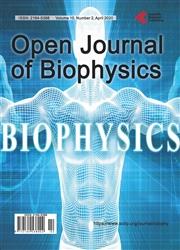Mechanics of Twisted DNA Molecule Adsorbed on a Biological Membrane
引用次数: 0
Abstract
DNA is the carrier of all cellular genetic information and increasingly used in nanotechnology. The study of DNA molecule achieved in vitro while submitting the DNA to all chemicals agent capabilities to destabilize links hydrogen, such as pH, temperature. In fact, the DNA enveloped in the membrane cellular, so it is legitimate to study the influence of membrane undulations. In this work, we try to show that the fluctuations of the membrane can be considerate as a physics agent is also capable to destabilize links hydrogen. In this investigation, we assume that each pair base formed an angle an with the membrane’s surface. We have proposed a theoretical model, and we have established a relationship between the angle formed by the pair base θeq and an angle formed by the membrane and each pair base. We assume that DNA and biomembrane interact via a realistic potential of Morse type. To this end, use is made of a generalized model that extends that introduced by M. Peyrard and A. R. Bishop in the past modified by M. Zoli. This generalized model is based on the resolution of a Schrodinger-like equation. The exact resolution gives the expression of the ground state, and the associated eigenvalue (energy) that equals the free energy, in the thermodynamic limit. First, we compute the denaturation temperature of DNA strands critical temperature. Second, we deduce all critical properties that mainly depend on the parameters of the model, and we quantify the effects of the membrane undulations. These undulations renormalize all physical quantities, such as harmonic stacking, melting temperature, eigenfunctions, eigenvalues and regular part of specific heat.扭曲DNA分子在生物膜上的吸附力学
DNA是所有细胞遗传信息的载体,越来越多地用于纳米技术。DNA分子的研究是在体外完成的,同时将DNA提交给所有化学试剂,如pH值、温度等,以破坏氢链的稳定性。事实上,DNA包裹在细胞膜中,因此研究细胞膜波动的影响是合理的。在这项工作中,我们试图表明膜的波动可以被认为是一种物理剂,也能够破坏氢链的稳定。在这项研究中,我们假设每对碱基与膜表面形成一个角。我们提出了一个理论模型,并建立了由一对碱基θeq形成的角与膜与每一对碱基形成的角之间的关系。我们假设DNA和生物膜通过莫尔斯型的现实电位相互作用。为此,使用了一个广义模型,该模型扩展了过去由M. Peyrard和a . R. Bishop引入的模型,并由M. Zoli修改。这个广义模型是基于类薛定谔方程的解析。精确的分辨率给出了基态的表达式,以及在热力学极限下等于自由能的相关特征值(能量)。首先,我们计算了DNA链的临界变性温度。其次,我们推导了主要依赖于模型参数的所有关键特性,并量化了膜波动的影响。这些波动使所有物理量重新规范化,如谐波叠加、熔化温度、特征函数、特征值和比热的规则部分。
本文章由计算机程序翻译,如有差异,请以英文原文为准。
求助全文
约1分钟内获得全文
求助全文

 求助内容:
求助内容: 应助结果提醒方式:
应助结果提醒方式:


